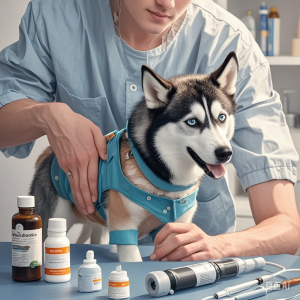Like many dog breeds, Huskies are prone to a variety of health issues, particularly concerning their skin. Despite their adaptability to cold climates, neglecting their dermatological needs can lead to the onset of certain diseases, conditions, or problems. Proper care, however, can help prevent or mitigate these typical skin issues in Huskies.
Whether you’re a potential or seasoned Husky owner, our guide outlines the most common skin problems Huskies face, along with their symptoms and treatment options.

First: Zinc-Responsive Dermatosis
When discussing “Husky skin problems” with veterinarians, zinc-responsive dermatosis often tops the list. This treatable condition arises from inadequate levels of the essential mineral zinc in the dog’s body. Prolonged zinc deficiency can manifest as skin lesions and accompany a range of symptoms in Husky puppies.
Causes:
- Type 1: Common in Alaskan breeds like Huskies, caused by reduced zinc absorption in the digestive tract.
- Type 2: More prevalent in large breeds fed diets high in phthalates and calcium, which bind with zinc and hinder absorption. Seen in Great Danes, German Shepherds, and Doberman Pinschers.
- Type 3: Occurs when dogs fail to consume sufficient zinc through their diet, typically due to low-quality or unbalanced food.
Symptoms:
- Inflamed skin around the mouth, ears, and nose
- Hair loss (alopecia)
- Itchy, red eyes (may indicate other eye issues in Huskies)
- Thickened skin at joints
- New bacterial or yeast infections
- Depression
- Weight loss
- Diarrhea, growth retardation, dull coat
Treatment:
- Addressing any symptoms or secondary infections
- Restoring normal zinc levels through diet, medication, or intravenous supplementation, depending on the cause.
Second: Mycosis Fungoides
Mycosis Fungoides is an autoimmune disorder, a lifelong skin condition where the immune system attacks healthy cells. In this disease, the immune system targets the connective tissue between skin cells, leading to skin problems and lesions. It’s most common in senior Huskies over four years old but can affect them at any age.
Causes:
Complex and multifaceted, including genetics, environment, a combination of factors, or no clear cause (idiopathic). Inflammatory triggers in older Huskies may include breed predisposition, viral infections, UV exposure, medications, and allergies.
Symptoms:
- Severe cases may present with hair loss, scabbing, ulcers, crusting, and open wounds around the face. As the disease progresses, it may spread to other body parts. Untreated, these lesions can become infected.
Treatment:
- While incurable, routine care can manage symptoms. Treatment involves antibiotics or antivirals for infections, alternative medications (if current ones exacerbate symptoms), allergy medications, sunscreen for affected areas, and fragrance-free, gentle cleansers.
Third: Husky Allergies
Huskies can develop allergies to numerous substances, from grass to dust mites, leading to severe allergic dermatitis or eczema. While not the most allergic breed, they are still susceptible, particularly to food allergies.
Causes:
- Allergies are autoimmune reactions where the immune system overreacts to specific allergens. Triggers in dogs include insects, dust mites, pollen, mold spores, proteins (soy, beef, etc.), household chemicals, and medications.
Symptoms:
- Can manifest in various ways, from diarrhea and vomiting (food allergies) to coughing or respiratory distress (mold spores). Skin allergies present as itching, redness, greasy appearance, hard texture, excessive scratching, yeast odor, and secondary infections (bacterial, fungal). Commonly affects ears, feet, belly, armpits, or nose but can occur anywhere.
Treatment:
- Immune-modulating medications for mild allergies to everyday substances
- Antibiotics, antifungals, or antimicrobials for infections
- Desensitization therapy to reduce symptoms by gradually exposing dogs to small amounts of allergens
- Good skincare routines to improve coat quality and alleviate symptoms
Fourth: Demodicosis in Huskies
Demodicosis, also known as mange, is a common skin issue in dogs, including Huskies. It’s one of two scabies diseases in dogs, caused by parasites residing on the skin. While more prevalent in certain cases, it’s treatable.
Causes:
- Caused by tiny mites (Demodex canis) living in dog hair follicles. Most dogs have small populations of these mites, but they proliferate when the immune system is compromised, leading to demodicosis. Huskies with weakened immune systems, such as puppies under 18 months, seniors, or those with other illnesses, are more susceptible.
Symptoms:
- Can be localized or generalized, with symptoms like hair loss, skin redness, scaling or crusting, lesions, and skin infections.
Treatment:
- Involves eliminating the mites under veterinary guidance, possibly through clipping hair, regular bathing with medicated shampoo or conditioner, and topical or oral mite control medications.
Husky Skin Care Tips:
While Huskies’ coats require minimal grooming, simple practices can maintain healthy skin:
- Bathe with medicated shampoo only when necessary due to odor or dirt accumulation.
- Brush twice weekly, more often if needed.
- Use antibacterial products like sprays or gels on wounds.
- Schedule regular grooming sessions, especially in summer or hot weather.
- Feed veterinarian-approved food to ensure all nutritional needs are met.